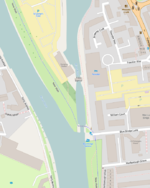St Clement's Church is a parish church on Scarcroft Road, south-west of the city centre of York, in England.
There was a mediaeval church dedicated to Saint Clement, lying outside the York city walls, which gave its name to the suburb of Clementhorpe. In 1130, the Benedictine Nunnery of St Clement was founded, and the church was later recorded as forming part of the nunnery complex. The nunnery was dissolved in 1536, but the church remained in use until 1585, when its parish was merged into St Mary Bishophill Senior. The church fell into ruin, and in 1745 the remaining stone from the church was removed and used to repair the walls.There was much construction in the area in the 19th century, and a new church was constructed as a chapel of ease to St Mary, on a site on Scarcroft Road. It was designed by J. B. & W. Atkinson, and was constructed from 1872 to 1874. In 1876, it was given its own parish. A vestry was added in 1880. St Mary was demolished in 1963, and many of its fixtures were relocated to St Clement, including monuments and boards, two of which record the terms of John Carr as Lord Mayor of York. The church was Grade II listed in 2000.
The church is constructed of red brick, with stone dressings and plinth and dark brick bands. It has angled buttresses, and a steep slate roof covering both nave and chancel, topped by a small bellcote. The nave has side aisles, and the east end is in the form of an apse. The windows are lancets, those at the east and west ends having three lights, with two-light windows either side. The stained glass in the east window was designed by Jean-Baptiste Capronnier in 1875. Inside, the arcades are of brick, with stone piers and detailed stone capitals. There is a circular stone font, and an octagonal stone pulpit. The choir stalls and screen are later, and were designed by Robert Thompson.












